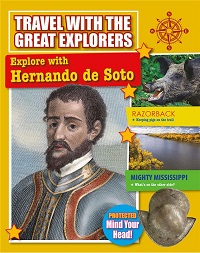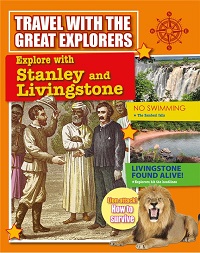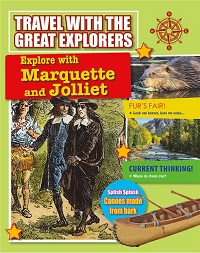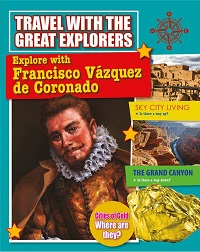| ________________
CM . . .
. Volume XXIII Number 34. . . .May 12, 2017
excerpt:
Crabtree Publishing continues to add titles to their already extensive “Travel with the Great Explorers” series, which, generally, has been favourably reviewed in CM. Students will be able to explore the motives of the European explorers, motives which have been historically described as “for god, glory and gold”—spread Christianity and enhance the prestige and wealth of their country as well as for themselves. In this quartet of books in the series, students trek across the African continent with Englishman David Livingstone and American Henry Stanley as these 19th century explorers searched for the source of the Nile river. They travel with 16th century Spanish explorers Hernando de Soto and Francisco Vazquez de Coronado. De Soto travelled through the southern regions of North America and was the first European to cross the Mississippi River. Coronado, who set out to find mythical cities of gold, didn’t find them, but he was the first European to see the Grand Canyon and the great western plains. Then there are the 17th century French explorers, Jacques Marquette and Louis Jolliet, who hoped to find a water route through North America to the Pacific Ocean and Asia. Although the Frenchmen failed in their quest, they explored the vast expanse of territory from the great lakes to the Gulf of Mexico. Each volume follows the same format: “Meet the Boss”--a short biographical sketch of the explorer’s backstory; “Where are We Heading”— a description of the lands they were exploring; “The Voyage”— a map of the exploration; “Meet the Crew” --the other individuals taken on the voyage or who were met during the journey of discovery; “Check Out the Ride”—the differing ways in which the explorers travelled on their journey; “Solve it With Science”—the varying skills and tools the explorer had to have and carried on their travels; “Hanging at Home”—how the explorers tried to live with some degree of comfort in harsh and dangerous surroundings; “Meeting and Greeting”—who were the local peoples and how the explorers related to them; “More Encounters; I Love Nature”—an examination of the local flora and fauna; “Fortune Hunting”—what valuable commodities were the explorers looking to exploit as to increase their own personal wealth or their state’s; “This Isn’t What They Said in the Brochure”—an examination of the disappointments the explorers faced; “End of the Road”—a examination of the accomplishments and the legacy of the explorers. Each volume concludes with a glossary, timeline, list of resources and an index. As well, the books are well-illustrated with drawings, archival materials, and photographs. Beyond the motivations of the explorers, students will be able to delve deeper into a variety of subject areas because of the format each book in the series follows. Students might contrast the personalities of the explorers. They might compare the lives and habitats of the various native peoples the explorers encountered and consider how the interactions affected the indigenous peoples. They might examine the distinct climates and the types of flora and fauna found in different geographical areas of Africa or North and South America. They might study how various explorers learned to adapt to the new conditions they faced. They might ask what scientific innovations, as well as medical discoveries, made the 16th through 19th century voyages of exploration possible. Classrooms and libraries that purchase several books in the series will be able to put them to good use for a variety of purposes. Recommended. Ian Stewart taught in Winnipeg School Division and is happily retired.
To comment
on this title or this review, send mail to cm@umanitoba.ca.
Copyright © the Manitoba Library Association. Reproduction for personal
use is permitted only if this copyright notice is maintained. Any
other reproduction is prohibited without permission.
Next Review | Table of Contents For This Issue - May 12, 2017 |



